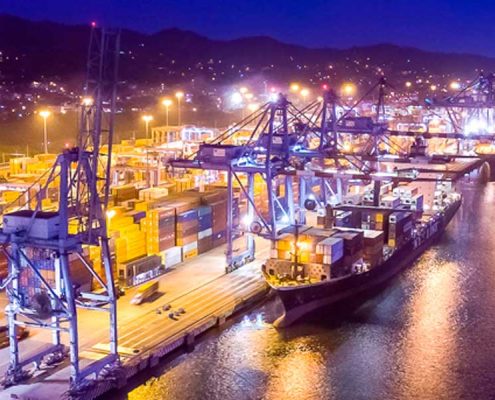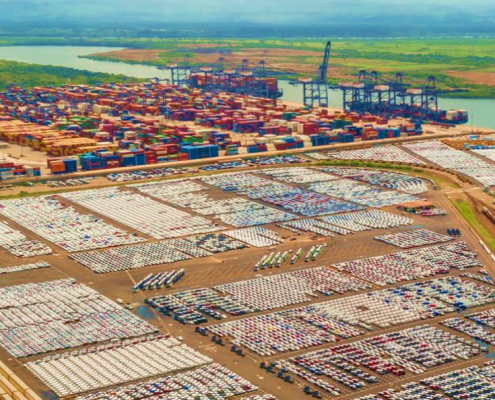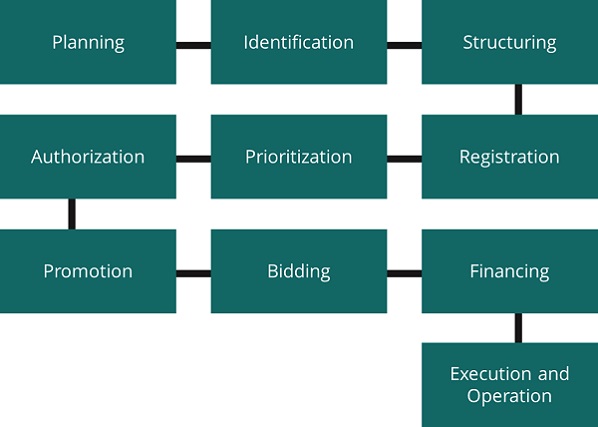Last review: November, 2025
Banobras offers interested parties information on the sector in Mexico with data from various sources in order to provide knowledge on the subject and useful elements for decision-making at the sectoral level. The content presented does not reflect the position of Banobras.
TITLE of Concession for the Integral Port Administration of the Port Area of the Port of Bahía Colonet, Municipality of Ensenada, in the State of Baja California, granted in favor of the Integral Port Administration of the State of Baja California, S.A. de C.V. (November 21, 2025). View document
Current status
In Mexico, the General Coordination of Ports and Merchant Marine (CGPMM) of the Ministry of the Navy (SEMAR), through the General Directorate of Port Development and Administration, conducts, coordinates and promotes planning, programming and evaluation actions for the promotion of the integral development of the 12 federal Administrations of the National Port System (ASIPONAS) sectorized to the Ministry of the Navy and the 4 ASIPONAS of the multimodal platform of the Interoceanic Corridor of the Isthmus of Tehuantepec (CIIT).
The ASIPONAS, constituted as priority public companies, are in charge of the planning, programming, development, use, exploitation and exploitation of the port under concession, being self-sufficient, productive and competitive. They may also grant partial assignment of rights to private companies for the construction, operation and exploitation of terminals, marinas and port facilities.
The partial assignment of rights has allowed for increased competitiveness in the sector by allowing the entry of private companies specialized in the handling of merchandise.
Mexico has 118 port terminals (18 federal and 6 state) divided as follows:
- 103 ports
- 15 terminals, of which 6 are specialized container terminals (TEC) and 9 are multipurpose terminals.

Source: Ministry of Infrastructure, Communications and Tranport, Manzanillo Port.
On July 23, 2025, the Government of Mexico, through the Ministry of the Navy, announced a federal investment of 55,179 million pesos (MXN) for the modernization and expansion of six strategic ports: Ensenada; Manzanillo and Nuevo Manzanillo; Lázaro Cárdenas; Acapulco; Veracruz; and Progreso.
The modernization of these ports aims to increase their capacity for receiving cruise ships and handling container cargo. Additionally, for Puerto Progreso, the goal is to make it the most important port in the Yucatán Peninsula.
The investment for the port modernization is distributed as follows:
- Ensenada Port: Investment of 5,636 million pesos
- Manzanillo Port: Investment of 20,500 million pesos
- Lázaro Cárdenas Port: Investment of 7,471 million pesos
- Acapulco Port: Investment of 670 million pesos
- Progreso Port: Investment of 5,636 million pesos from the Government of Mexico
Maritime connectivity
In 2024, more than 272 million tons of total cargo were mobilized through the National Port System, of which more than 80% corresponds to ASIPONAS, in addition to a total of 9.37 million containers (TEUs).
The increasing size of vessels is a growing trend, particularly evident at ports along the Pacific coast that receive routes from Asia. In this context, the capacity to accommodate large-scale ships has become strategically important.
Seaports are fundamental to world trade, as they provide access to any continent and country. According to the document “El Desarrollo Portuario Requerido para México” by the CGPMM, 82% of the world’s goods are transported by sea.
Mexico has connectivity with 63 countries through 316 ports, with the arrival of 145 regular shipping lines: 124 ocean-going and 21 coastal shipping lines. In terms of value, 38% of imports and 20% of exports were carried by sea. In addition, maritime transport accounted for 30% of the total cargo transported.
The United Nations Conference on Trade and Development (UNCTAD) indicates that, in the third quarter of 2024, Mexico ranked 28th internationally and third in Latin America according to the maritime connectivity index, surpassed only by Panama, which highlights its integration in global maritime trade routes.
Land connectivity
According to the Railway Transportation Regulatory Agency, rail connectivity at ports is a key factor for the development of intermodal corridors in the country. Currently, 69% of the ports managed by federal ASIPONAS have rail connection. However, there are challenges to improve the integration of these corridors, especially through last mile connection projects, shortening and rehabilitation of railroad tracks.
Currently, 10% of cargo at federal ports is handled by rail. Although complete statistics on container cargo at all ports are not available, at the Port of Lázaro Cárdenas, only 18% of cargo is operated by rail (ASIPONA Lázaro Cárdenas, 2023).
On the other hand, more than 90% of the goods handled in the ports are transported by road, which represents a major challenge in transportation management, especially in ports that can handle more than 3,000 trailers in a single day.
In addition, SEMAR, through the General Coordination of Ports and Merchant Marine, offers a map of the location of ports in Mexico:
Institutional Arrangement
In terms of infrastructure, Mexico has a defined strategy that offers investors medium and long-term visibility regarding the development of projects, through a series of plans and programs of national and sectorial scope. To access the information, please consult the following documents:
Navy Sector Program 2025–2030
Organizational Structure
Description of the hierarchy and roles of the different entities and actors involved in the sector, including how the different institutions and agencies coordinate and collaborate.
It is the Federal Government agency and authority responsible for the sector, in charge of promoting adequate transportation and communications systems that contribute to the accessibility of services, responding to globalization trends.
Area of the SICT in charge of the growth process of modern and sufficient maritime transportation.
General Directorate of Ports
Unit of the SICT in charge of establishing port policy; processing concessions, permits and authorizations in Mexico’s ports, authorizing or constructing port, maritime and dredging works.
General Directorate of Merchant Marine
Unit of the SICT in charge of regulating and implementing policies that promote the sufficiency and safety of maritime transportation and fostering the national merchant marine.
General Directorate of Port Development and Administration
SICT unit in charge of promoting the integral development of the national port system, coordinating and promoting the administrative efficiency and profitability of the Integral Port Administrations (API).
Private and/or public concessions constituted through commercial companies that are entrusted with the planning, programming, development and other acts related to the assets and services of a port, for the use, development and exploitation of the assets and the rendering of the respective services. There are 16 federal ASIPONAS, 6 state, 2 of the Fondo Nacional de Fomento al Turismo (FONATUR) and 1 private.
Its purpose is to employ the naval power of the Federation for the external defense and to assist in the internal security of the country, under the terms established by the Political Constitution of the United Mexican States, the laws derived therefrom and international treaties.
The Port Captaincy is the maritime authority in each authorized port and exercises the powers conferred by the laws and regulations.
They aim to provide face-to-face and online educational models, innovative and aligned to the national digital strategy, integrated to the education, production and services sectors, to provide human capital to the supply chains of goods and meet the demand of global trade, privileging the geographical location of Mexico.
Legal system
The compilation of international treaties, laws, regulations, decrees, agreements and federal, state and municipal provisions shown here are for informational purposes and for ease of reference:
SICT
Public Works and Related Services Law

Source: General Coordination of Ports and Merchant Marine, “The Logistic World Summit Expo”, 2024.
Investment cycle
The following section provides an overview of the project development process from initial planning to final execution.

Planning
SICT establishes short, medium and long term sectorial programs for ports infrastructure development, based on the objectives and strategies defined by the National Development Plan and the National Infrastructure Program. The principal objectives are to: a) encourage the creation of two complementary port systems; b) promote the development of four world class ports; c) improve the connectivity of internal ports; and, d) expedite customs and fiscal services, and improve port captaincy management.
Identification
SICT identifies required port infrastructure, in accordance with planning documents. Unsolicited proposals of PPP projects must be aligned to national and sectorial plans.
Structuring
The Port Administration and Development General Direction prepares, by itself or by means of third parties, the necessary pre-investment studies and analysis, required for the development of port and merchant navy projects.
Registration
For those projects that require federal funds, SCT presents a registration application to the Investment Unit of the Ministry of Finance (whether funded with fiscal budget or by the National Infrastructure Fund or FONADIN).
Prioritization
The CIGFD will evaluate the projects that require the allocation of federal funds, and will decide its inclusion in the draft of the annual expenditure budget. Additionally, this commission will determine the prioritization of the projects based on: a) socioeconomic profitability; b) its impact in extreme poverty reduction; c) regional development, and d) concurrence with other programs and investment projects.
Authorization
- Projects that require federal funds are authorized by by the House of Representatives.
- Projects with funding from FONADIN are authorized by the Fund.
- The IU will issue an opinion of economic viability for those projects that do not require public resources.
Promotion
The Ports and Merchant Navy General Coordination and the Port Administrations are the entities responsible for the promotion of the projects.
Bidding
The bidding process is responsibility of The Ports and Merchant Navy General Coordination and/or the Port Administrations, and it must be registered in ComprasMX.
Financing
The bidding process is responsibility of The Ports and Merchant Navy General Coordination and/or the Port Administrations, and it must be registered in CompraNet.
Execution and Operation
Carried out by the Port Administrators (operators), under the surveillance of SICT, according to contract terms.
Projects
Information on new projects (pre-investment, bidding and execution) and in operation within the Mexico Projects Hub platform, which at some stage of the project were considered investment opportunities and do not necessarily have Banobras / Fonadin participation.
New Projects
| Project | Sector | Subsector | Stage | Sustainability | With Ally Networks |
| Interoceanic Corridor of the Isthmus of Tehuantepec | Transport | Ports | Execution | No | No |
| 0997 Multipurpose Terminal in the Port of Guaymas | Transport | Ports | Bidding | No | No |
| 0970 Lázaro Cárdenas Port: Multiple Use Terminal (cabotage cargo, mineral bulk and general cargo) | Transport | Ports | Bidding | No | No |
| 0924 Tourist Marina in Ensenada, Baja California | Transport | Ports | Preinvestment | No | No |
| 0910 Cruise Terminal in Ensenada, Baja California | Transport | Ports | Preinvestment | No | No |
Projects in Operation
| Proyect | Sector | Subsector | Sustainability | Ally Networks |
| 0670 New Port of Veracruz: Mixed-Cargo Terminal for General, Containerized and Mineral Bulk Cargo | Transport | Ports | Yes | No |
| 0023 New Port of Veracruz: Terminal for the Management of Minerals | Transport | Ports | Yes | Yes |
| 0021 New Port of Veracruz: Specialized Bulk Agricultural Products Terminal | Transport | Ports | Yes | Yes |
| 0020 New Port of Veracruz: Specializad Fluids Terminal | Transport | Ports | Yes | Yes |
| Project | Sector | Subsector | Stage | Sustainability | With Ally Networks |
|---|---|---|---|---|---|
| Interoceanic Corridor of the Isthmus of Tehuantepec | Transport | Ports | Execution | No | No |
| 1034 Specialized Terminal for Mineral Bulk Cargo in the Southern Area of the Port of Guaymas | Transport | Ports | Bidding | No | No |
| 1030 Specialized Mineral Bulk Terminal at the Port of Guaymas | Transport | Ports | Bidding | No | No |
| 0997 Multipurpose Terminal in the Port of Guaymas | Transport | Ports | Execution | No | No |
| 0970 Lázaro Cárdenas Port: Multiple Use Terminal (cabotage cargo, mineral bulk and general cargo) | Transport | Ports | Bidding | No | No |
| 0924 Tourist Marina in Ensenada, Baja California | Transport | Ports | Bidding | No | No |
| 0910 Cruise Terminal in Ensenada, Baja California | Transport | Ports | Preinvestment | No | No |
| Project | Sector | Subsector | Stage | Sustainability | With Ally Networks |
|---|---|---|---|---|---|
| 0670 New Port of Veracruz: Mixed-Cargo Terminal for General, Containerized and Mineral Bulk Cargo | Transport | Ports | Operation | Yes | No |
| 0023 New Port of Veracruz: Terminal for the Management of Minerals | Transport | Ports | Operation | Yes | Yes |
| 0021 New Port of Veracruz: Specialized Bulk Agricultural Products Terminal | Transport | Ports | Operation | Yes | Yes |
| 0020 New Port of Veracruz: Specializad Fluids Terminal | Transport | Ports | Operation | Yes | Yes |
Banobras / Fonadin
BANOBRAS and FONADIN can participate in the financing of port terminals and/or infrastructure or equipment investments in ports.
Project Finance: In order to support the financing of infrastructure projects and public services, the Project Finance Unit structures financing supported by the granting of loans and guarantees to those projects developed as Public-Private Partnerships and which have their own source of payment from the exploitation of the concession or public contract or from the collection of the service in question. The Public-Private Partnership schemes may be Federal and/or Local, in their different modalities, such as: Concessions, Service Provision Projects (PPS) or Financed Public Works Contracts, among others.

Financing for States and Municipalities and Decentralized Public Organizations: The products and services are designed to meet the infrastructure needs of states, municipalities and their decentralized public organizations, in order to improve the quality of life of the population and increase competitiveness.
Infrastructure is a pillar of development, which is why Banobras has innovative products and services focused on contributing to regional development through the promotion of financial mechanisms to:
Boost investment in infrastructure and public services.
Promote the financial and institutional strengthening of states, municipalities and decentralized public agencies.
To this end, Banobras has the following financing schemes:
Products:
Project Development: Banobras offers services aimed at assisting public sector agencies and entities in the development of infrastructure projects.
Financial structuring of the project:
- Elaborate and/or update studies required by the Public-Private Partnerships Law.
- Support in the review of the bidding conditions and contract model.
- Assist in obtaining financing for the project.
- Assist in the registration process of the project in the portfolio of the Investment Unit of the Ministry of Finance and Public Credit (SHCP).
- Assist in dealing with any observations made by the SHCP Investment Unit.
- Support in the financial closing of the project.
The purpose of the National Infrastructure Fund (Fonadin) is to serve as the Federal Public Administration’s coordination vehicle for infrastructure investment. It has one of the largest road concession networks in the world and manages the granting of financial support for infrastructure development, mainly in the areas of communications, transportation, water, environment, energy, tourism, urban and strategic and priority areas, supporting the planning, promotion, construction, conservation, operation and transfer of infrastructure projects with social impact and economic or financial profitability.

It has a wide range of products designed to strengthen the financial structure of the infrastructure projects that the country requires, from the conception to the completion of the projects, providing the following financial instruments that make the projects more attractive for financing with private resources:
Recoverable Support
- Simple Credits
- Subordinated Credits
- Guarantees
- Investments in Venture Capital Funds
- Infrastructure Trust Investments
- Financing of Studies and Advisory Services
Non Recoverable Support
- Contributions for Studies and Consultancy
- Contributions for Projects
- Project Grants
Contact: fonadin.transporte@banobras.gob.mx
Sustainability
Banobras makes available to interested parties, analysis sheets for the detection of sustainability practices in infrastructure projects, in accordance with the methodological framework “Attributes and Framework for Sustainable Infrastructure” of the Inter-American Development Bank (IDB). Its objective is to highlight sustainable practices, encourage their adoption in future projects and provide relevant information for investors in their economic, environmental, social and institutional dimensions.
To consult the projects that already have a sustainability record, select the “SEARCH CRITERIA>” option in the PROJECTS section, and then select “With Sustainability Analysis”; the projects that have a record will be displayed below.
In addition, Banobras offers an analysis tool that presents the potential relationship of the different infrastructure projects of the Mexico Projects platform with the 17 Sustainable Development Goals (SDGs) of the 2030 Agenda and their targets. This comparative analysis facilitates the use of data according to different criteria, such as the potential impact of projects and sectors against national and global development goals.
The comparison is only made between projects in the same subsector. To select and consult here.
The alignment of a project with the SDGs provides information on the degree of focus on sustainability; it provides a comparison between projects in the same sector and sub-sector and facilitates investment decisions, showing the highest and lowest alignment of projects to the SDGs. Comparative analysis facilitates the use of data according to different criteria, such as the potential impact of projects and sectors against national and global development goals.
In the case of the sector, 4 projects are identified in the platform that have sustainability practices detection sheets, which allows to know, among other things, the projects with more and better alignments to the SDGs. For more information, access the Sustainable Development Goals application:
Greater alignment of the sector:
- SDG 8: Decent work and economic growth
- SDG 9: Industry, innovation and infrastructure
- SDG 11: Sustainable cities and communities
Reduced alignment of the sector:
- SDG 2: Zero hunger
- SDG 4: Quality education
- SDG 10: Reducing inequalities
- SDG 14: Life below water
- SDG 17: Alliances to achieve objectives
Ally Networks
Banobras, through its Ally Networks application, provides information on companies participating in competitive public procurement processes for infrastructure projects in Mexico, based on official sources such as ComprasMX. It includes details on investment amounts, number of participations in bids, projects awarded, consortiums, and business associations, which allows the user to identify potential actors for the establishment of investments in the country.
To consult the projects that have information on the participating companies, select the option “SEARCH CRITERIA>” in the PROJECTS section, and then select “With applicant companies” at the end of the criteria.
In the application, you can consult on the sector:
- 3 projects
- 14 companies
- 3 consortiums
- 3 Projects
- 14 Companies
- 3 Consortiums
Reference documents:
This section offers documents, reports and reports with technical, statistical and regulatory information on the sector:
Official Statements:
2025
- DOF: TITLE of Concession for the Integral Port Administration of the Port Area of the Port of Bahía Colonet, Municipality of Ensenada, in the State of Baja California, granted in favor of the Integral Port Administration of the State of Baja California, S.A. de C.V.
- DOF: Agreement approving the Institutional Programs of the National Port System Administrations 2025-2030.
- DOF: Navy Sector Program 2025–2030.
- Presidency of the Republic: The Government of Mexico, through the Ministry of the Navy, announced that a public investment of 55.179 billion pesos and a private investment of 241.051 billion pesos will be allocated for the execution of priority projects in nine ports.
- DOF: AGREEMENT delegating powers to the head of the Undersecretariat of Communications and Transport of the Ministry of Infrastructure, Communications and Transport.
Additional information:
2025





